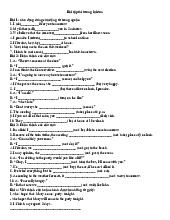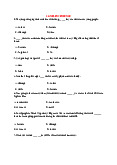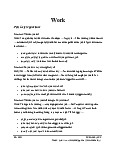



Preview text:
1. Which of the following symbols corresponds to the following phonetic description: voiceless velar nasal ? A. [ g ] B. [ k ] C. [ d ] D. [ ŋ ]
2. Which of the following symbols corresponds to the following phonetic description: voiceless dental fricative ? A. [ ] B. [ m ] C. [ t ] D. [ d ]
3. Which of the following segments corresponds to the following phonetic description: long low back vowel ? A. [ i: ] B. [ Ø: ] C. [ u: ] D. [ a: ]
4. Which of the following symbols corresponds to the following phonetic
description: lax low front vowel ? A. [ i: ] B. [ e ] C. [ I ] D. [ A ]
5. Which of the following statements is correct? Palatal is made A. at the hard palate B. at the teeth ridge
C. at the soft area toward the rear of the roof of the mouth
D. with the tongue placed against the teeth
6. Which of the following phonetic transcriptions corresponds to the following phonetic description:
high back rounded tense vowel ? A. [ Ø: ] B. [ i: ] C. [ u: ] D. [ u ]
7. Which of the following words has a consonant cluster? A. sea B. guard C. teacher D. play
8. Which of the following symbols corresponds to the following phonetic description: long mid back vowel ? A. [ Ø: ] B. [ a: ] C. [ i: ] D. [ ] u:
9. Which of the following is NOT considered (an) articulator(s)? A. the tongue B. the lips C. the velum D. the ears
9. Which of the following statements is correct?
Nasal sounds are produced with
A. the airstream released through the oral cavity
B. with the velum being lowered
C. the continuous air flow through the mouth D. A & C
10. Which of the following phonetic transcriptions corresponds to the following
phonetic description: voiced palato-alveolar affricate ? A. [ j ] B. [ tS ] C. [ dZ ] D. [Z ]
11. Which of the following phonetic variations may happen to the lateral [ l ] in this context: [ ' teibl ] table?
A. [ l ] becomes devoiced after the voiced stop [ b ]
B. [ l ] becomes syllabic after the voiced stop [ b ]
C. [ l ] becomes unaspirated after the voiced stop [ b]
D. [ l] becomes aspirated after the voiced stop [ b ]
12. In the articulation of the ………… sound, the central of the tongue is raised toward the palate. A. central B. back C. front D. open
13. Which of the following phonetic transcriptions corresponds to the following phonetic description:
voiced bilabial nasal ? A. [ m ] B. [ n ] C. [ŋ ] D. [ w ]
14. Which of the following words contains a close vowel? A. sand B. sit C. hard D. hot
15. Which of the following statements is correct?
The affricates [t ] and [ d ] are
A. consonants produced with a continuous airflow through the mouth
B. consonants produced with the lowering of the soft palate
C. consonants produced with the complete stoppage of the air in the mouth which causes explosion
D. produced with an initial stop then with a slow separation of the tongue to make friction
16. Which of the following symbols corresponds to the following phonetic description: voiceless
labiodental fricative ? A. [ f ] B. [ w ] C. [n ] D. [ v ]
17. Which of the following statements is correct?
Palato-alveolar is the sound made
A. just behind the alveolar ridge
B. with the identical articulation to that of the long vowel [ i:]
C. as a very rapidly articulated non-syllabic segment
D. with the tongue at the alveolar ridge
18. Which of the following statements is correct?
All the consonants are produced with
A. an extra puff of the air strongly expelled
B. an obstruction of the airstream (complete or partial)
C. no vibration of the vocal cords
D. vibration of the vocal cords
19. Which of the following groups contains a segment that differs in manner of articulation from the other segments?
A. [ , D, s, z ] B. [ w, r, j, l ] C. [ p, b, z, d ] D. [ t, d, g, p ]
20. When the vocal cords are vibrating, the sounds they produce might be ………. A. /p, t and k/ B. / s, k and t/ C. /p, s and k/ D. /a:, I and i:/
21. Which of the following symbols corresponds to the following phonetic description: long high front vowel ? A. [ i: ] B. [e] C. [A] D. [ I ]
22. Which of the following groups contains a segment that differs in
place of articulation from the other segments? A. [ k, w, n, g ] B. [ t, d, n, s ] C. [ p, m, w, b ] D. [ t, d, z, n ]




